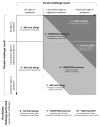A new framework for the documentation and interpretation of oral food challenges in population-based and clinical research
- PMID: 27670637
- PMCID: PMC5324701
- DOI: 10.1111/all.13049
A new framework for the documentation and interpretation of oral food challenges in population-based and clinical research
Erratum in
-
Corrigendum.Allergy. 2020 Jul;75(7):1837. doi: 10.1111/all.14230. Allergy. 2020. PMID: 32652628 Free PMC article. No abstract available.
Abstract
Background: The conduct of oral food challenges as the preferred diagnostic standard for food allergy (FA) was harmonized over the last years. However, documentation and interpretation of challenge results, particularly in research settings, are not sufficiently standardized to allow valid comparisons between studies. Our aim was to develop a diagnostic toolbox to capture and report clinical observations in double-blind placebo-controlled food challenges (DBPCFC).
Methods: A group of experienced allergists, paediatricians, dieticians, epidemiologists and data managers developed generic case report forms and standard operating procedures for DBPCFCs and piloted them in three clinical centres. The follow-up of the EuroPrevall/iFAAM birth cohort and other iFAAM work packages applied these methods.
Recommendations: A set of newly developed questionnaire or interview items capture the history of FA. Together with sensitization status, this forms the basis for the decision to perform a DBPCFC, following a standardized decision algorithm. A generic form including details about severity and timing captures signs and symptoms observed during or after the procedures. In contrast to the commonly used dichotomous outcome FA vs no FA, the allergy status is interpreted in multiple categories to reflect the complexity of clinical decision-making.
Conclusion: The proposed toolbox sets a standard for improved documentation and harmonized interpretation of DBPCFCs. By a detailed documentation and common terminology for communicating outcomes, these tools hope to reduce the influence of subjective judgment of supervising physicians. All forms are publicly available for further evolution and free use in clinical and research settings.
Keywords: decision-making; double-blind method; food hypersensitivity; oral food challenge; symptom assessment.
© 2016 The Authors. Allergy Published by John Wiley & Sons Ltd.
Figures



References
-
- Sampson HA, Gerth van Wijk R, Bindslev‐Jensen C, Sicherer S, Teuber SS, Burks AW et al. Standardizing double‐blind, placebo‐controlled oral food challenges: American Academy of Allergy, Asthma & Immunology‐European Academy of Allergy and Clinical Immunology PRACTALL consensus report. J Allergy Clin Immunol 2012;130:1260–1274. - PubMed
-
- Nowak‐Wegrzyn A, Assa'ad AH, Bahna SL, Bock SA, Sicherer SH, Teuber SS. Work Group report: oral food challenge testing. J Allergy Clin Immunol 2009;6(Suppl):S365–S383. - PubMed
-
- Niggemann B, Beyer K. Pitfalls in double‐blind, placebo‐controlled oral food challenges. Allergy 2007;62:729–732. - PubMed
-
- Niggemann B, Beyer K. Diagnosis of food allergy in children: toward a standardization of food challenge. J Pediatr Gastroenterol Nutr 2007;45:399–404. - PubMed
MeSH terms
Substances
LinkOut - more resources
Full Text Sources
Other Literature Sources
Medical

